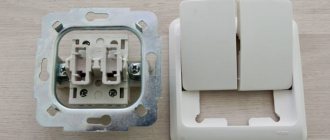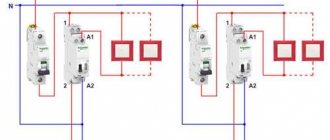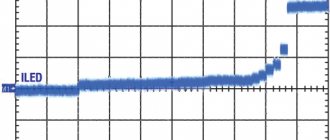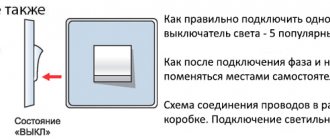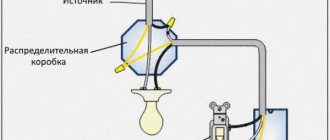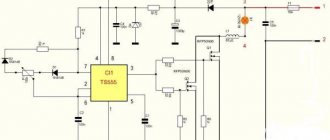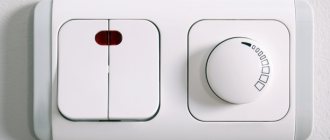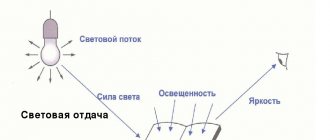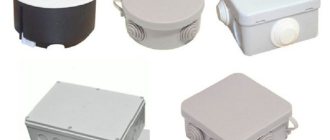Adjusting the brightness of lamps may be necessary to reduce the level of illumination or dim the light. Modern electronics allows you to do this by using the simplest and small-sized devices called dimmers. The dimmer switch, in addition to the usual function of turning lamps on/off, regulates the amount of voltage supplied to them, thus changing the brightness of the light.
Dimmer
In addition to reducing brightness, there is a significant reduction in energy consumption and extension of the service life of the light source. When an incandescent lamp (regular or halogen) is connected to the network, a current surge occurs, since a cold spiral has a low ohmic resistance, and until the spiral warms up, a large current flows through it. Although this time is a fraction of a second, the vast majority of lamp failures occur at the moment of switching on. An adjustable light switch allows you to reduce the initial surge of current through the lamp. Smooth heating of the filament leads to an increase in the service life of the lamps.
Dimmer purpose
The main purpose of such devices is to regulate the brightness of incandescent or halogen lamps. Halogen lamps that operate at reduced voltage are controlled using a dimmer connected through a step-down transformer. These devices can be purchased separately, but it is better to buy a dimmer with a built-in transformer.
Attention! To work in lighting circuits with LED and fluorescent lamps, it is necessary to use special dimmers.
To control energy-saving lamps, devices are used whose design includes an additional element - an electronic starter.
Using the brightness control as a light switch, you can arbitrarily change the lighting intensity from maximum to dimmest. In this case, there is no need to use double or triple switches to control the operation of chandeliers with several lamps. In addition, it makes no sense to purchase expensive lamps equipped with their own voltage regulators.
Adjustment principle
Light adjustment can be done in two ways:
- Rheostat;
- Triac.
Rheostat method
The first thing that comes to mind when it comes to changing voltage or current is the inclusion of a current-limiting element, a resistor, in series with the light source. A variable resistor for this application is called a rheostat, and the adjustment principle itself is called rheostatic. The advantages of this solution are simplicity and the absolute absence of interference, as well as flickering of lamps. But that's where all the advantages end. The reason for refusing to regulate using resistors was the extremely low efficiency of voltage regulation. After all, if you look carefully, it becomes clear to even an inexperienced consumer that excess voltage remains on the resistor. This voltage drop is released as heat. This forces us to make rheostats with high permissible power dissipation and solve the problems of removing excess heat.
Turning on the lamp through a rheostat
Note! The rheostatic method does not provide any gain in energy consumption; on the contrary, when the load voltage decreases, the overall efficiency drops, since most of the electricity is converted into heat.
Triac method
The main method of adjusting the brightness of lighting devices at present is the use of triacs. A triac is a semiconductor device that has three terminals, two of which are connected to the load circuit, and the third is supplied with a control voltage that allows switching the load circuit.
The alternating current that is used to power the lamps is in the form of a sine wave. At a frequency of 50 Hz, which is standard for us, in one second the current changes its value from zero to a maximum 100 times (here we take into account the fact that both the positive and negative sections of the sine wave are equivalent).
By controlling the operation of a triac, you can interrupt the flow of electric current in a certain section of the sinusoid. The larger part of it is cut off from the load, the lower the brightness of the lamps will be.
The principle of triac adjustment
Note! Some sources talk about thyristor regulators. This is not important. A thyristor differs from a triac only in that it operates with a voltage of the same polarity. To be included in an alternating current circuit, an additional diode bridge is needed, and a triac does not need a bridge, but they work exactly the same.
There is a drawback with triac regulation: at the moment the triac is switched, especially if it occurs in a section of the sinusoid close to the maximum, a surge of powerful interference occurs that can disrupt the normal operation of various equipment. In particular, interference is very clearly audible when radio receivers are operating. To reduce the level of interference, it is necessary to install additional filters that complicate the design. At minimum brightness, lamp flickering may be noticeable as the pause between on and off states increases.
On a note. An undoubted advantage is electronic regulation, thanks to which it is possible to control using microcontrollers and introduce additional functions.
In DC circuits, dimming is performed using pulse-width modulation. Instead of direct current, power is supplied in the form of high frequency pulses. By changing the ratio of the duration (width) of pulses and pauses between them, the average voltage level is adjusted. In order to make flickering invisible, the pulse repetition rate is high.
PWM modulation
Dimmer classification
There are currently several types of monoblock dimmers on the market:
- Dimmers with a mechanical regulator, which is made in the form of a rotary disk. The design of such products is relatively simple, which explains their quite reasonable price. There are dimmers with push or turn switching. In the first case, to close the electrical circuit, you need to lightly press the control knob; devices of the second type always turn on the light, starting from its minimum intensity.
- Dimmers with push-button control. They are more complex devices, but their functions are significantly expanded due to the possibility of combining such regulators into groups, which can be controlled from the remote control.
- Touch dimmers. They are quite expensive, but also the most prestigious devices that fit perfectly into the interiors of rooms decorated in a modern style. In addition, touch-sensitive models, like dimmers of the previous type, are equipped with signal receivers that allow you to change the lighting intensity using an infrared remote control or via radio.
In addition to monoblock dimmers, there are devices with modular control, which is carried out using a remote button or a key switch. Such regulators are used to control lighting in public places, as well as for installation in distribution boxes.
As already mentioned, most dimmer models are designed for use in circuits with incandescent or LED lamps.
When choosing a dimmer, you need to pay special attention to its power, which must exceed the total maximum power of all consumers connected through this device. Today, in electrical goods stores you can find light controllers with a power of 40 W to 1 kW.
As for the design, there are single, double and triple dimmers on the market. Moreover, the vast majority are single models.
Types of indoor dimmers
Room lighting controllers are divided into two groups:
- Mechanical;
- Sensory.
Illuminated switch
Mechanical regulators have the simplest design. On the outer surface there is an adjustment knob mounted on the variable resistor shaft.
Note! The fact that the lighting is controlled using a variable resistor does not mean that this device operates using a rheostatic method. A variable resistor changes the parameters of the control pulses supplied to the thyristor.
Mechanical dimmer
The undoubted advantage of such regulators is that in the off position the network wires are mechanically open, and the light is always turned on only from the minimum voltage level.
In turn, touch devices also have a large number of options, including:
- Touch switch with mechanical adjustment;
- Touch switch with brightness control without mechanical devices.
The first type is completely identical to the mechanical regulator above, except that the light is turned on and off by touching the sensing element. The lighting turns on immediately to the preset level.
Touch-mechanical regulator
Fully electronic devices perform adjustments according to a given algorithm by touching the corresponding sensitive elements. The presence of a built-in microcontroller allows programming the device using a variety of operating algorithms. You can set the desired lighting level at a certain time of day. Regulators with a microcontroller can de facto be used with a remote control.
Touch controller
All of the listed options can be designed to adjust the lighting of one lighting fixture, or for several. Externally, they differ in the presence of several keys, visually separated from each other.
Design of switches with dimmer
The main element of the dimmer design is the electrical circuit, which is designed to reduce the effective value of the voltage supplying the load.
Ensuring reliable operation of this circuit is carried out using several types of protection, which include protection against short circuit, overvoltage and overheating.
Like a regular light switch, the dimmer has a metal frame that allows you to easily install it in a standard socket box.
Connection options
- Connecting the dimmer to the switch. Wires are connected to the terminals of the device. Installation is carried out at the location of the switch. Upon completion of installation work, the correct operation of the device is tested.
- A switch with a built-in dimmer is no different from a conventional switch installation. The structure is connected to the wiring and fixed.
- The dimmer is connected simultaneously with a simple switch. In this case, additional buttons are simply installed near the bed.
Device diagram
The main element of the electrical circuit on which the dimmer switch is built is a bidirectional triode thyristor - a device that is an electronic switch controlled by a short pulse.
One of the most common brightness control circuits is shown in the figure.
The signal to open and close the thyristor is supplied using a capacitor of a certain capacity, which accumulates charge during the passage of the first half-wave of the supply voltage.
Connection diagram with two dimmers
A scheme in which two dimmers are involved at once has become widespread. They are installed at two points in any room and perform the functions of pass-through switches, controlling a separate chandelier or lamp.
This method involves connecting three wires to the junction box from each point. Connecting two dimmers is quite simple. It is necessary to connect jumpers to the corresponding first and second contacts in each dimmer. Subsequently, a phase is supplied to the third contact of the first dimmer, which goes to the lamp through the third contact of the second device.
Principle of operation
Modern dimmers are not consumers of electrical power. This is their fundamental difference from earlier analogs that operated using an active or capacitive voltage divider circuit.
Previous generations of voltage regulators were either rheostats connected in series with the load or autotransformers. In both cases, the manufacture and use of such devices turned out to be extremely expensive. The use of a rheostat, in addition to significant financial costs, led to a significant increase in the weight of the light controller. In addition, when current flows through the rheostat, it becomes very hot, which leads to significant power losses and forces the need to consider the need to cool this device.
Unlike a rheostat, an autotransformer is not a consumer of energy, but it has an extremely large mass and dimensions.
It is possible to avoid power losses in the dimmer due to an electrical circuit that allows you to supply power to consumers by “cutting off” the front or rear part of the half-wave of the supply voltage. This operating principle is called phase control with cutting off the leading or trailing edge.
The operating principle of a dimmer that cuts off the leading edge of a half-wave of a voltage sine wave:
The figure shows the shape of the supply voltage in a circuit whose circuit contains a controlled thyristor, which is automatically turned on when the voltage reaches zero.
Depending on the operating mode, which is determined by the response time (from 0 to 9 ms), it is possible to achieve a smooth change in the power consumed by the lighting device.
Leading dimmer manufacturers
- The products of the French company Schneider Electric are characterized by their attractive appearance and the quality of the materials used. Such features make the devices popular.
- The German company has been creating electrical equipment for a long time, so light controllers have also appeared in the line. You will be pleased with the functionality, build quality and attractive design.
- Sensors, touch buttons and similar devices are the main products of the Czech company Teco. Dimmers from this manufacturer will delight you with the combination of price and quality.
Dimmers are modern devices that should be installed in every room. This approach will provide comfort and also save on electricity. The range of products will pleasantly surprise the consumer, but it is important to consider compatibility with lamps and connection features. Plan where the fixture will be placed to match the room's design.
Dimmer installation
The connection of a single brightness control is carried out according to the same scheme as the installation of an ordinary key switch. Thus, when installing a dimmer instead of an existing switch, there is no need to make any changes to the electrical wiring design.
The connection diagram, as well as the dimensions of the socket box and the marking of the terminals are absolutely identical.
Some difficulties may arise only if the light dimmers are connected as pass-through switches or combined into groups controlled by a remote control. A diagram of their connection of three outputs for connecting electrical wires.
Enabling regulators
As a rule, lighting regulators have two terminals and are installed instead of a regular switch. There are subtleties when installing electronic regulators.
It is advisable to install them in series with a classic switch, which allows you to switch the lighting, regardless of the position of the regulator.
Like mechanical switches, dimmers are available for use in pass-through mode. Two regulators installed in different parts of the room allow you to control the lighting using any of them. Such devices contain a switch with normally closed and normally open contacts and are identified by the presence of three terminals for connection. The connection diagram is shown on the back of the device.
Connecting a pass-through dimmer
Advantages and disadvantages of using dimmers
Advantages:
- The ability to arbitrarily change the brightness of light in a room not only greatly increases the ease of use of the lamps, but also provides wide scope for interesting design solutions.
- Reducing the voltage at the consumer without dissipating power allows for significant energy savings.
- When operating at reduced voltage, the life of the lamps is significantly extended.
- Using a dimmer can to some extent protect the consumer from voltage surges, which are one of the main reasons for the failure of incandescent lamps.
- The lamps are turned on at the moment the supply voltage sinusoid passes through zero, which prevents a sharp increase in the current in them.
Flaws:
- The relatively high price of these dimmers compared to conventional key switches.
- If it is necessary to replace a double or triple switch with a dimmer, significant difficulties arise associated with the purchase of an expensive double dimmer model or equipment of additional points for installing two or three such devices.
- Distortion of the supply voltage curve. This drawback does not greatly affect the performance of active energy consumers such as incandescent lamps. At the same time, the use of dimmers can have an extremely negative impact on the operation of electronic consumers.
Thus, the use of dimmers as lighting regulators is completely justified in cases where a smooth change in the brightness of the light is really necessary. At the same time, due to the high cost of these devices, using them instead of all switches in the apartment seems impractical.
Dimmers for different types of lamps
Since there are now many lamps of different types of light and voltage levels, different dimmers are used for them.
- Dimmers for incandescent and halogen lamps of standard voltage,
Almost all dimmers fit here. It must be remembered that as the voltage decreases, the color temperature of the emitted light changes. Taking on a reddish tint, light at low voltage will be unpleasant and harmful to the eyes.
- Regulators for low voltage halogen lamps,
Regulation of a halogen source with a voltage range of 12-24V requires the presence of a transformer to reduce the voltage, marked with RL symbols. If an electronic transformer is installed, you need a dimmer marked C.
Regulating devices designed for low-voltage lamps are equipped with a mechanism for smoothly turning off and turning on the light. The service life of such devices can be significantly reduced due to sudden voltage changes.
- Dimmers for high voltage electrical circuits,
Such adjustable switches are often used to control the brightness of theater lighting. Given the high power consumption of energy, it is necessary to install dimmers that are resistant to heavy loads.
- Dimmers designed for fluorescent sources
This type of lighting has some difficulties with regulation, since the standard method of reducing voltage does not work here. Therefore, the design of such devices requires the presence of a special starting device. It converts the supplied frequency into the range from 20 to 50 kHz. The change in frequency determines the value of the current flowing through the lighting circuit. At the same time, the brightness level also changes.
- Dimmers for LED light sources.
Smooth control of the brightness of LED sources is carried out by applying pulse width modulation. The duration of the current pulses supplied to the LED with optimal amplitude changes, thereby changing the level of luminous flux. Thanks to the high pulse frequency, reaching 0.3 MHz, the possibility of lamp flickering is eliminated.
If the device does not work
Many dimmer models have their own fuse. If it doesn't work, find and check it. If so, the fuse can be easily replaced with a new one. Fuses are divided based on operating speed (F - fast action, M - normal, T - slow-acting).
To change the fuse, you need to turn off the electricity in the apartment. After removing the handle, unscrew the screw and remove the top cover. Use a screwdriver to remove the fuse bracket. After replacing it, we put the bracket with it in place.
After removing the regulator cover, replace the fuse
The regulator cover and knob are also returned to their places. The automatic switch on the panel turns on the electricity in the apartment.
